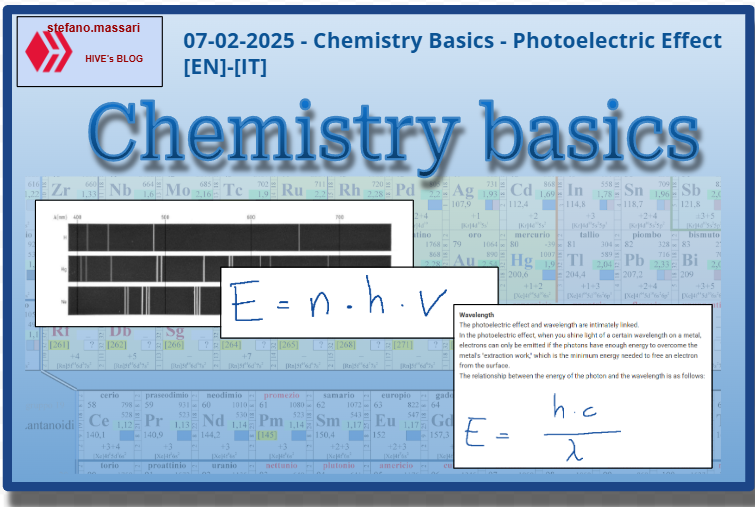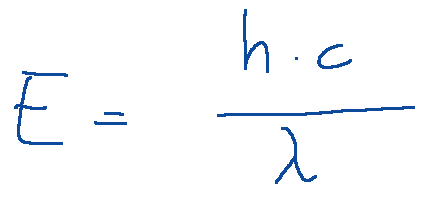
~~~ La versione in italiano inizia subito dopo la versione in inglese ~~~
ENGLISH
07-02-2025 - Chemistry Basics - Photoelectric Effect [EN]-[IT]
With this post I would like to give a short instruction about the topic mentioned in the subject
(code notes: X_96)
Photoelectric Effect

The photoelectric effect is considered as follows.
The emission of electrons from the surface of a metal illuminated by monochromatic light of sufficient energy, with the consequent generation of electric current
In other slightly different words.
The photoelectric effect is a physical phenomenon in which electrons are emitted from the surface of a material when it is hit by light or other electromagnetic radiation.
It was Albert Einstein, in 1905, who explained this effect. He also understood that light itself is of a particle nature and is made up of “quanta” of energy, called photons.
NOTE: For the explanation of the photoelectric effect, Mr. Einstein took the Nobel Prize in Physics in 1921.
In the photoelectric effect, the kinetic energy of the emitted electrons depends on the frequency of the incident light, not on the intensity of the light.
In the photoelectric effect, the kinetic energy of electrons, emitted when a metal is hit by a light of a suitable frequency (i.e. greater than the threshold frequency), doubles if the frequency of the light doubles
Before Einstein's statement in 1905 regarding the photoelectric effect, a person who was very important in arriving at this statement was Max Plank.
In fact, until 1901, according to classical physics, light only has a wave nature to which a continuous flow of energy is associated.
However, this did not explain three phenomena:
-Black body radiation
-Photoelectric effect
-Atomic spectra
NOTE: The black body is an ideal system capable of absorbing all the incident energy. As a result, it heats up and re-emits energy whose frequency is strictly linked to the temperature at which it is found.
Max Plank in 1901 filled the gaps described by understanding that a body at high temperature is i
ncapable of emitting (or absorbing) only certain amounts of energy.
From here comes the following equation dedicated to quantized energy:

Where:
-𝐸 is the energy of the quantum level
-𝑛 is the principal quantum number, a positive integer (n=1,2,3,...) that indicates the energy level occupied by the electron.
-ℎ is Planck's constant
-𝜈 is the frequency of the associated electromagnetic radiation
Wavelength
The photoelectric effect and wavelength are intimately linked.
In the photoelectric effect, when you shine light of a certain wavelength on a metal, electrons can only be emitted if the photons have enough energy to overcome the metal's "extraction work," which is the minimum energy needed to free an electron from the surface.
The relationship between the energy of the photon and the wavelength is as follows:

Where:
- 𝐸 is the energy of the photon.
- ℎ is the Planck constant (6.626×10^−34 J⋅s).
- 𝑐 is the speed of light (3×10^8m/s).
- 𝜆 is the wavelength of light.
Basically, from this equation we can understand that the energy of photons is quantized and depends on the wavelength. From here we can say that quantum mechanics originated.
Conclusions
The phenomenon of the photoelectric effect represented a crucial turning point in understanding the nature of light and in the formulation of the modern theory of the atom.
Question
Did you know that the Nobel Prize for Physics that Einstein won in 1921 was for his explanation of the photoelectric effect?

[ITALIAN]
07-02-2025 - Basi di chimica - Effetto fotoelettrico [EN]-[IT]
Con questo post vorrei dare una breve istruzione a riguardo dell’argomento citato in oggetto
(code notes: X_96)
Effetto fotoelettrico

L'effetto fotoelettrico viene considerato come segue.
L'emissione di elettroni dalla superficie di un metallo illuminata da luce monocromatica di energia sufficiente, con la conseguente generazione di corrente elettrica
In altre parole leggermente diverse.
L'effetto fotoelettrico è un fenomeno fisico in cui degli elettroni vengono emessi dalla superficie di un materiale quando esso è colpito dalla luce o da altra radiazione elettromagnetica.
Fu Albert Einstein, nel 1905, a spiegare questo effetto. A lui fu chiaro anche che la luce stessa è di natura particellare ed è costituita da “quanti” di energia, detti fotoni.
NOTA: Per la spiegazione dell'effetto fotoelettrico, il Sig. Einstein prese il Premio Nobel per la Fisica nel 1921.
Nell'effetto fotoelettrico, l'energia cinetica degli elettroni emessi dipende dalla frequenza della luce incidente, non dall'intensità della luce.
Nell'effetto fotoelettrico l'energia cinetica degli elettroni, emessi quando un metallo è colpito da una luce di opportuna frequenza (cioè maggiore di quella di soglia), raddoppia se la frequenza della luce raddoppia
Prima dell'affermazione di Einstein del 1905 a riguardo dell'effetto fotoelettrico, una persona che fu molto importante per arrivare a questa affermazione fu Max Plank.
Infatti, fino al 1901, secondo la fisica classica la luce ha solo una natura ondulatoria a cui viene associata un flusso continuo di energia.
Però questo non spiegava tre fenomeni:
-Radiazione del corpo nero
-Effetto fotoelettrico
-Spettri atomici
NOTA: Il corpo nero è un sistema ideale in grado di assorbire tutta l’energia incidente. A seguito di questo si scalda e riemette energia la cui frequenza è strettamente legata alla temperatura a cui si trova.
A sopperire alle mancanze descritte ci pensa Max Plank nel 1901 che riesce a comprendere che un corpo ad alta temperatura è i
n grado di emettere (o di assorbire) solo certe quantità di energia.
Da qui nasce la seguente equazione dedicata all'energia quantizzata:

Dove:
-𝐸 è l'energia del livello quantico
-𝑛 è il numero quantico principale, un intero positivo (n=1,2,3,...) che indica il livello energetico occupato dall'elettrone.
-ℎ è la costante di Plank
-𝜈 è la frequenza della radiazione elettromagnetica associata
La lunghezza d'onda
L'effetto fotoelettrico e la lunghezza d'onda sono intimamente collegati.
Nell'effetto fotoelettrico, quando illumini un metallo con luce di una certa lunghezza d'onda, gli elettroni possono essere emessi solo se i fotoni hanno abbastanza energia per superare il "lavoro di estrazione" del metallo, cioè l'energia minima necessaria per liberare un elettrone dalla superficie.
La relazione tra l'energia del fotone e la lunghezza d'onda è la seguente:

Dove:
- 𝐸 è l'energia del fotone.
- ℎ è la costante di Planck ( 6,626×10^−34 J⋅s).
- 𝑐 è la velocità della luce (3×10^8m/s).
- 𝜆 è la lunghezza d'onda della luce.
Sostanzialmente da questa equazione si può comprendere che l'energia dei fotoni è quantizzata e dipende dalla lunghezza d'onda. Da qui possiamo dire che ha avuto origine la meccanica quantistica.
Conclusioni
Il fenomeno dell'effetto fotoelettrico ha rappresentato una svolta cruciale nella comprensione della natura della luce e nella formulazione della moderna teoria dell'atomo.
Domanda
Lo sapevate che il nobel per la Fisica che vinse Einstein nel 1921 lo vinse per la sua spiegazione dell'effetto fotoelettrico?
THE END





